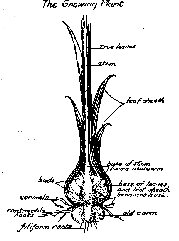|
FEEDING AND AFTER CARE |

|
Terry took us though the growing season and stressed the importance of looking well after the corms - yes, corms, not bulbs. The difference is that while bulbs e.g. daffodils increase in size and then divide, a corm replaces itself with a new corm each year. Little cormlets will also form at the base of the new corm which are detached and can be grown on to reach flowering size in two to five years. |
|
In December inspect and snap the heads off. Ideal storing conditions are in shallow trays or mesh bags in a room with good air circulation and temperatures between 38°F and 48°F. 50% humidity is preferred, but dryer conditions and temperatures a little warmer are tolerated. If you have ordered corms, unpack corms on arrival, and take the husk off, check for disease - healthy corms are 'absolutely solid'. Label and set out to sprout. This leads to the formation of nodules at the base of the corm, which will sprout roots as soon as it goes into the ground, very important as otherwise the corm may rot in cold soil. Remove all but the strongest shoot. (However, more shoots are usually left on for the smaller flowering primulinus group) continued |